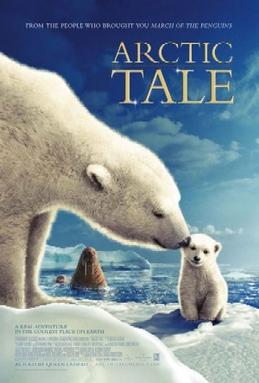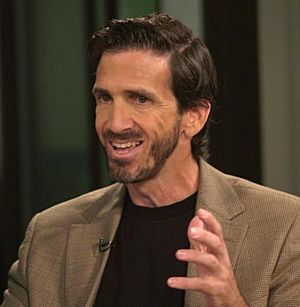Arctic Tale facts for kids
Quick facts for kids Arctic Tale |
|
|---|---|

Theatrical release poster
|
|
| Directed by | Adam Ravetch Sarah Robertson |
| Produced by | Adam Leipzig Keenan Smart |
| Written by | Linda Woolverton Mose Richards Kristin Gore |
| Narrated by | Queen Latifah |
| Music by | Joby Talbot |
| Cinematography | Adam Ravetch |
| Editing by | Beth Spiegel |
| Studio | National Geographic Films |
| Distributed by | Paramount Classics |
| Release date(s) | July 25, 2007 (limited) |
| Running time | 86 minutes |
| Country | United States |
| Language | English |
| Money made | $1,858,064 |
Arctic Tale is a 2007 American documentary film that tells the story of animals living in the Arctic. It follows the life of a walrus and her baby, and a polar bear and her cubs. The movie shows how these amazing animals survive in their icy home.
The film was directed by Adam Ravetch and Sarah Robertson. The famous singer and actress Queen Latifah narrates the story. The animal characters, like "Nanu" the polar bear and "Seela" the walrus, are based on many different animals of their kind.
Contents
Filming the Arctic Story
The amazing footage in Arctic Tale was filmed over 15 years. Filmmakers Adam Ravetch and Sarah Robertson, along with the National Geographic team, worked hard to capture these rare moments. They collected over 800 hours of video!
It's usually very hard to film animals like polar bears and walruses. Even though you see them together in the movie, they don't often meet in real life. The filmmakers learned that polar bears and walruses actually have a lot in common.
Meet Nanu and Seela: An Arctic Adventure
The movie begins with Nanu, a baby polar bear, leaving her snow cave. She is with her brother and their mother. The two cubs play in the snow and then learn how to survive. Their mother teaches them to stay away from big male polar bears, who can be dangerous.
We also meet Seela, a baby walrus. She is in the water with her mother and "Auntie," who helps protect her. Seela learns how to climb onto an ice floe from the water. Auntie watches for dangers, like a male polar bear swimming nearby.
Hunting for Food in the Arctic
Nanu's mother teaches her cubs how to hunt for food. They learn to find fur seals hidden under the ice. After one try, the mother catches a seal, and her cubs get to eat. A fox even gets some leftovers!
Meanwhile, young Seela and her walrus family feast on clams. They spend three days eating from a clam bed. They might not visit that same spot again for five years.
Challenges of a Changing Arctic
As the film continues, both Nanu and Seela face challenges. The Arctic ice is melting faster and freezing later because of warmer temperatures. This makes it harder for them to find food and survive.
Male polar bears are a threat to both Nanu's family and the walruses. Nanu's brother sadly dies, and Nanu has to leave her mother earlier than usual. She struggles to find food on her own. Eventually, she finds a male bear who has caught a walrus, which is Auntie. Nanu bravely convinces the male bear to share his meal.
New Beginnings
Later, Nanu finds a mate and they are seen playing together. Seela waits for a special male walrus's song before she dives into the water to meet him.
The movie ends with new life. Nanu gives birth to two cubs of her own. Seela also has a baby, a female calf. The cycle of life continues in the Arctic.
A Message for Our Planet
Throughout the film, Queen Latifah talks about how rising temperatures affect the animals. A message at the end of the movie warns that if current trends continue, there might be no Arctic ice left by the year 2040.
During the credits, children share their thoughts on global warming. They explain how it harms animals and people around the world. The film encourages viewers to learn more about protecting our planet.
Awards and Recognition
Arctic Tale was nominated for the Panda Award in 2008 at the Wildscreen Festival. It was also nominated for the Genesis Award in Los Angeles. This award celebrates media that honors animals.
Soundtrack Highlights
The Arctic Tale soundtrack features several songs.
- "At the Edge of the World" by Aimee Mann & Zach Gill plays at the start of the film.
- "Live Let Live" by Brian Wilson plays during the ending credits.
- "Song of the North (Beneath the Sun)" by Grant-Lee Phillips is heard twice in the film.
- "Black Wave" by The Shins plays as the animals face challenges in their changing environment.
- "We Are Family" by Sister Sledge is played when Seela meets her walrus herd.
- "Happy Ever After in Your Eyes" by Ben Harper is the final song as Nanu and Seela have their babies.


